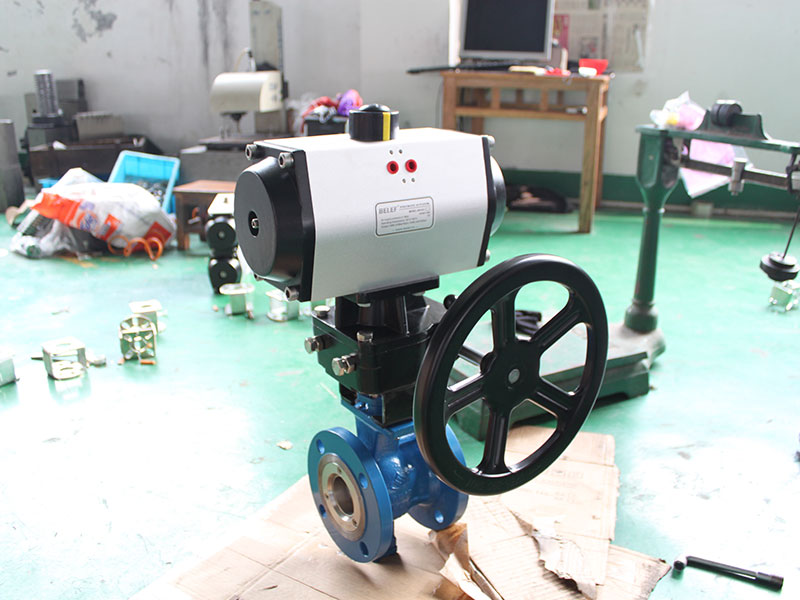Common faults and causes of pneumatic actuators include: the control valve does not work, the control valve movement is unstable, the control valve vibrates, the control valve moves slowly, the control valve leakage increases, and the flow adjustable range becomes smaller.
1. The control valve does not work
1. No signal, no air source.
①The gas source is not turned on, ②The air pipe is blocked or the gas source enters water, the filter and the pressure reducing valve are blocked, and freezes in winter, ③The compressor is malfunctioning; the gas source main pipe is leaking.
2. There is air source but no signal
① Regulator failure; ② Leakage of signal tube; ③ Leakage of positioner bellows; ④ Damage of regulating mesh.
3. The positioner has no air source
①The filter is blocked; ②The pressure reducing valve is faulty; ③The pipeline is leaking or blocked.
4. The positioner has air supply but no output. The orifice plate of the positioner is blocked.
5. There is a signal but no action
①The valve core falls off. ②The valve core and the valve seat are stuck together; ③The valve stem is bent or broken; ④The valve seat and the valve core have frozen or burnt dirt; ⑤The actuator spring is rusted due to long-term use.
Solution: Replace the solenoid valve, replace the coil, and clean the dirt.
2. The operation of the control valve is unstable
1. The pressure of the air source is unstable.
①The compressor capacity is too small; ②The pressure reducing valve is faulty.
2. The signal pressure is unstable.
①The time constant of the control system (T=RC) is inappropriate; ②The output of the regulator is unstable.
3. The air source pressure is stable and the signal pressure is also stable, but the action of the regulating valve is still unstable.
①The ball valve of the amplifier in the positioner is not closed tightly due to dirt and wear, and the output will oscillate when the air consumption is particularly increased; ②The nozzle baffle of the amplifier in the positioner is not parallel, and the baffle cannot cover the nozzle; ③The output pipe and line leak ; ④The rigidity of the actuator is too small; ⑤The frictional resistance of the valve stem is large and the contact part is blocked.
3. Control valve vibration
1. The regulating valve vibrates at any opening.
①The bracket is unstable; ②There is a vibration source nearby; ③The valve core and bushing are seriously worn.
2. The control valve vibrates when it is close to the fully closed position.
①The regulating valve is larger and is often used for small opening; ②The medium flow direction of the single seat valve is opposite to the closing direction.
4. Slow control valve action
1. Only when the valve stem moves in one direction, it is slow.
①The diaphragm in the pneumatic diaphragm actuator is damaged or leaking; ②The "O" seal of the actuator is leaking.
2. The valve stem is slow when it reciprocates.
①There is a sticky substance in the valve body; ②The PTFE packing has deteriorated and hardened or the graphite-asbestos packing lubricant is dry; ③The packing is too tight, and the friction resistance increases; ④The valve stem is not straight, and the friction resistance is large; ⑤Does not change position The pneumatic control valve of the device will also cause sluggish action.
5 Increase in the leakage of the regulating valve
1. Large leakage when the valve is fully closed.
① The valve core is severely worn and has serious internal leakage. ②The valve is not adjusted correctly, close it tightly.
2. The valve cannot reach the fully closed position.
①The medium pressure difference is too large, the rigidity of the actuator is small, and the valve is not closed tightly; ②There is foreign body in the valve; ③The bush is sintered.
6. The adjustable flow range becomes smaller
The main reason is that the valve core is corroded and becomes smaller, which makes the adjustable flow rate larger.
To understand the common failure phenomena and causes of the above pneumatic actuators, you can take corresponding measures to solve the failure phenomena.


 customer service1
customer service1  customer service2
customer service2 